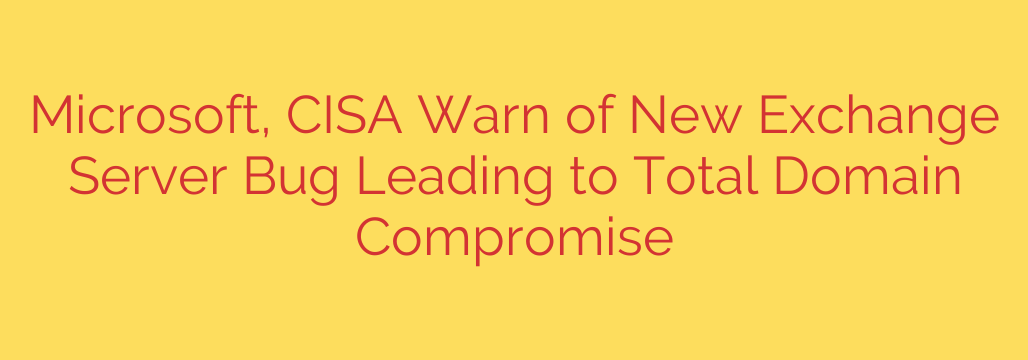
Critical Exchange Server Vulnerability Alert: How to Prevent a Full Network Takeover
A severe security flaw has been identified in Microsoft Exchange Server that could allow an attacker to gain complete control over your entire network. This vulnerability, which involves a privilege escalation attack, has been flagged by cybersecurity officials as a critical threat requiring immediate attention from IT administrators and security teams.
The core of the issue lies in a weakness that can be exploited through NTLM (New Technology LAN Manager) relay attacks. Essentially, a threat actor with even minimal access to your network could trick an Exchange Server into authenticating to a malicious server under their control. This maneuver allows the attacker to impersonate the Exchange Server, effectively stealing its high-level credentials.
The Impact: From a Single Server to Total Domain Compromise
The consequences of this attack are severe. The Exchange Server holds significant privileges within an Active Directory environment. By successfully impersonating it, an attacker can escalate their privileges to that of a Domain Administrator.
This isn’t just about accessing emails. Achieving Domain Admin status is the “keys to the kingdom” for an attacker, granting them:
- Complete control over your entire network domain.
- The ability to create, delete, and modify any user account.
- Unfettered access to all sensitive data across all servers and workstations.
- The power to deploy ransomware or other malware across the entire organization.
In short, this vulnerability can lead to a full-scale corporate data breach and network shutdown. Security researchers have demonstrated that this attack is not just theoretical but practical, making it a clear and present danger.
Actionable Steps: How to Protect Your Systems Now
Protecting your organization requires a swift and decisive response. Official guidance and security best practices recommend a multi-layered approach focusing on patching and proactive mitigation.
1. Apply Security Updates Immediately
The most effective way to eliminate this threat is to install the latest security patches. Keeping your Exchange Servers up-to-date is the single most important defense against known vulnerabilities. Prioritize the deployment of the official security updates provided for your version of Exchange Server. Do not delay this process, as attackers are known to rapidly develop exploits once a vulnerability is publicly disclosed.
2. Implement Critical Mitigation Measures
If you cannot patch immediately, or as an additional layer of defense, you must take steps to block the attack vector. The primary method involves protecting Exchange Server accounts from NTLM relay abuse.
The recommended mitigation is to add the Exchange Server computer accounts to the ‘Protected Users’ security group in Active Directory. This is a crucial step because accounts in this group are restricted to using the more secure Kerberos authentication protocol, effectively blocking NTLM relay attacks against them.
Additional hardening steps include:
- Turn on EPA (Extended Protection for Authentication): This feature helps defend against man-in-the-middle attacks, which are a key component of this exploit.
- Require NTLMv2: If NTLM cannot be disabled entirely, ensure you are enforcing the use of NTLMv2, which offers more robust security features than older versions.
- Block SMB Outbound: Consider blocking outbound SMB traffic (TCP port 445) from your Exchange Servers to the internet to prevent them from communicating with external malicious servers.
Beyond the Patch: A Proactive Security Posture
While patching and mitigation are critical, this vulnerability serves as a stark reminder of the importance of defense-in-depth security principles.
- Principle of Least Privilege: Ensure that accounts and services—including the Exchange Server—only have the minimum permissions necessary to function. Regularly audit high-privilege accounts.
- Network Segmentation: Isolate critical servers like your Exchange Server and Domain Controllers from the general user network. This can limit an attacker’s ability to move laterally even if they gain an initial foothold.
- Monitor for Suspicious Activity: Actively monitor for unusual authentication requests, especially those involving NTLM, and look for signs of DCSync abuse, which is a common technique used by attackers after gaining high-level privileges.
The threat posed by this Exchange Server flaw is significant. By taking immediate action to patch your systems and implement strong security controls, you can protect your organization from a potentially catastrophic network compromise.
Source: https://go.theregister.com/feed/www.theregister.com/2025/08/07/microsoft_cisa_warn_yet_another/








